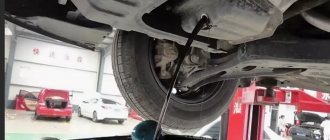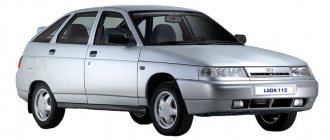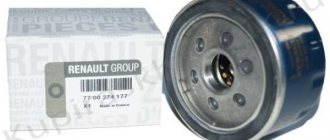Any internal combustion engine requires continuous lubrication. The VAZ 2106 engine is no exception in this sense. If the driver wants the car to be in good working order for many years, he will have to periodically change the oil in the engine. What's the best way to do this? Let's try to figure it out.
- Why does your engine oil need to be changed regularly?
- Draining oil from the VAZ 2106 engine
Oil drain sequence
- Flushing the VAZ 2106 engine and adding new oil
Sequencing
- Video: the best way to flush the engine
- Three types of motor oils
- Frequency of oil filter replacement
Flushing the VAZ 2106 engine and adding new oil
As mentioned above, draining oil from a VAZ 2106 engine takes a lot of time. But as a rule, even this time is not enough to completely drain the waste. The reason is simple: oil, especially old oil, has increased viscosity. And a certain part of this viscous mass still remains in the small holes and channels of the motor.
Residues of engine oil that cannot be removed from the VAZ 2106 engine using a regular drain
In order to get rid of these residues, the driver will have to resort to the engine flushing procedure. It is best to wash the engine using regular diesel fuel.
Sequencing
- After the oil is completely drained from the car, the oil filter is manually removed. In its place, a new filter is screwed in, purchased specifically for washing (it will only be needed once, so you can save on its quality).
- The drain plug is closed and diesel fuel is poured into the engine crankcase. You will need the same amount of oil as oil, i.e. about 5 liters. After this, the filler neck is closed with a plug, and the engine is cranked using the starter for 10 seconds. You cannot fully start the engine (and to achieve maximum effect, the right rear wheel of the car can be raised 8–10 cm using a jack).
- After this, the drain hole on the crankcase is twisted again using a socket wrench, and the diesel fuel, along with the remaining waste, is drained into a substitute container.
- Complete drainage of diesel fuel takes 5–10 minutes. Now the drain plug is screwed in, and new oil is poured into the crankcase through the neck.
Video: the best way to flush the engine
How to choose
In order not to make a mistake with your choice, you need to consider three aspects:
- what year of manufacture is the engine, what is its modification and how worn is it;
- in what weather conditions the car is operated;
- Does the engine have hydraulic compensators that control valve clearances?
The fact is that engine models that were produced before the 90s were equipped with oil seals and valve stem seals made of nitrile rubber. This material cannot interact with synthetic and semi-synthetic products.
Also, if hydraulic compensators are installed, then high-viscosity grades cannot be used. This applies to all types of engines, including modern ones.
In order not to make a mistake with your choice, it is best to look at the service documentation of your instance. This is where the permissible viscosity values, API, ACEA or ILSAC, as well as GOST are located. Of course, specific recommendations are likely to be outdated. But by understanding what characteristics a lubricant should have, you can buy from the modern assortment what is right for you.
If you still don’t know what oil to pour into the engine, you can use our reminder:
What kind of oil to pour into the VAZ 2106 engine
Which oil to choose for VAZ 2106? This is an important question, because the abundance of motor oils on the market literally makes the modern motorist’s eyes run wide. To answer the above question correctly, let’s figure out what motor oils are and how they differ from each other.
Three types of motor oils
All motor oils presented in auto stores are divided into three large groups:
- synthetic oils;
- semi-synthetic oils;
- mineral oils.
Now more details.
- synthetic oil is more expensive than others, which is not surprising: this lubricant has excellent temperature characteristics and a very uniform viscosity. Expensive “synthetics” do not harden even at -55°C, which is especially important for our climate, since it allows you to start the engine without problems even in the most severe frost;
- Semi-synthetic oil is a mixture of “synthetics” and mineral oil. It is worse than pure “synthetics”, its operating temperature range is not so wide, however, semi-synthetic oil also has an undoubted advantage: it is cheaper;
- Finally, mineral oil is the cheapest on the market. The viscosity of this oil is highly dependent on temperature. For example, at -30°C, mineral oil becomes very thick and resembles plasticine in viscosity.
Mineral oil thickens quickly in the cold and has a consistency similar to plasticine.
Choosing engine oil
Based on all of the above, we can draw a simple conclusion: you should choose engine oil for the VAZ 2106 depending on the climate. If the car is operated where the average annual temperature is positive, then the optimal choice for it would be simple mineral oil. For example, LUKOIL Super SG/CD 10W-40.
The best mineral oil for the VAZ 2107 is LUKOIL Super SG/CD 10W-40
If the car is operated primarily in a temperate climate (which prevails in the middle zone of our country), then semi-synthetics, such as Mannol Classic 10W-40, would be a good choice.
Semi-synthetic oil Mannol Classic 10W-40 is the optimal choice for central Russia
Finally, if the car owner lives in the Far North or close to it, then he will have to buy pure synthetics, such as MOBIL Super 3000.
MOBIL Super 3000 is an excellent synthetic oil for the VAZ 2106 that does not thicken even at very low temperatures
Another good synthetic option would be LUKOIL Lux 5W-30.
LUKOIL Lux 5W-30 is another good synthetic option for the VAZ 2106
Recommended Lubricants
The service books for the “sixes” contain information that is already outdated today. Therefore, the choice of optimal oil may be among the following brands:
- Lukoil Standard of various viscosities: 20/15/10W30, 15/10W40;
- LADA “Standard” 15/10W40, 5W30;
- Rosneft Optimum 10W30, 10/15W40.
Oils on a semi-synthetic basis are well suited, only with the above recommendations for engines, for example:
- Rosneft Maximum, 5/10W40, 5W30;
- Lukoil "Lux", 10W40;
- Lukoil "Super", 5/10W40.
All these lubricants are distinguished by their low price compared to imported products. If desired, you can use imported oils whose API is not lower than:
- SG/CD-II (from 1976 to 1990);
- SG/CE (1991–1994);
- SH/CF-4 (1995);
- SH/CF (1996);
- SJ/CF (1997);
- SJ/CG (1998-1999);
- SJ/CG-4 (2000);
- SJ/CH (2001);
- SH/CH-4 (2002);
- SJ/CH-4 (2003);
- SL/CH-4 (2004);
- SL/CI (2005–2006)
For 1976-1982 models, only mineral lubricant should be used. From 1983 to 1991 – hydrocracking and mineral water. From 1992 to 1994, semi-synthetics were added to the above. From 1995 to 2003 mineral water and semi-synthetics are used. Release 2004–2006 It is best to service it only with semi-synthetics. Popular oil brands include Rosneft, Mobil, Valvoline, Total and many others.
Oil filter device
As a rule, along with changing the oil, VAZ 2106 owners also change the oil filters. Let's figure out what this device is and how it works. By design, oil filters are divided into:
- modular;
- collapsible;
- non-separable.
Collapsible filters have a long service life and high cost. All that is required of the car owner is to periodically change the filter elements.
Non-separable oil filters have a much shorter service life, which is understandable: these are disposable devices that the driver simply throws away after they are completely dirty.
Finally, a modular filter is a cross between a collapsible and a non-separable filter. The housing of such a filter can be disassembled, but only partially, in order to remove the filter element. The rest of the design of such a filter is inaccessible to the user. At the same time, modular filters are more expensive than collapsible ones.
Whatever the filter housing, its internal “filling” is almost always the same. It is shown schematically in the photo below.
Oil filters on the VAZ 2106 have a similar design, differing only in the housings
The filter housing is always cylindrical. There are a pair of valves inside: one is direct-acting, the other is reverse-acting. There is also a filter element and a return spring. In addition, all oil filter housings have holes. They are located next to a rubber o-ring that prevents oil from leaking out.
Filter elements can be made of different materials. On inexpensive filters, they are made of ordinary paper, which is impregnated with a special composition, then folded into an “accordion” shape and placed in the housing of the filter element. This design allows you to increase the filter surface area several times and improve the quality of oil purification by 12 times.
Oil filter filter elements are made of ordinary paper with special impregnation
The purpose of a direct bypass valve is to allow oil to flow into the engine when the filter element is severely clogged. That is, the bypass valve is, in fact, an emergency device that provides continuous lubrication of all rubbing parts of the engine, even without preliminary oil filtration.
The check valve prevents oil from entering the crankcase after the engine is stopped.
From all that has been said above, we can draw a simple conclusion: the type of oil filter installed on the VAZ 2106 is determined only by the financial capabilities of the motorist. If he wants to save money, then the best option would be to install a modular or collapsible filter. A good choice would be MANN products.
MANN filters are in constant high demand among VAZ 2106 owners
CHAMPION modular filters also have a good reputation.
A good alternative to MANN filters can be an oil filter from CHAMPION
Yes, this pleasure is not cheap, but then you will have to spend money only on new filter elements, which are much cheaper than new disposable filters.
If your financial capabilities do not allow you to buy a reusable device, then you will have to limit yourself to a non-separable filter. The best option is the NF1001 filter.
Disposable non-removable filter NF1001
Frequency of oil filter replacement
The VAZ 2106 manufacturer recommends changing oil filters every 7 thousand kilometers. However, mileage is far from the only criterion for replacement. The driver should periodically monitor the condition of the engine oil using a dipstick. If dirt and various debris are visible on the dipstick, it means that the filter needs to be changed urgently.
Driving style is another factor that influences the frequency of oil filter replacement. The more aggressive it is, the more often these devices will have to be changed.
Finally, if the car is constantly operated at high temperatures, in heavy dust, dirt and in off-road conditions, then the filters will also have to be changed more often than the manufacturer recommends.
Work at the preparatory stage
In order for a car to function properly for many years, pleasing its owner, it is necessary to regularly carry out maintenance and change consumables. An extremely important aspect is to replace the lubricant in the engine. Many motorists think about how often it is recommended to change the oil in VAZ-2106 cars. Resolving the issue of choosing high-quality consumables deserves no less attention, because, first of all, you will have to pay attention directly to the purchase of oil and filter.
Alternative
A few years after the launch of the VAZ 2103 into production, the company introduced its modernized version - 2106.
What are the differences between the VAZ 2103 and the VAZ 2106?
The “Six” is distinguished not only by its later year of manufacture (since 1976).
The new car has differences in:
- A more powerful 1.6-liter engine that develops 80 horsepower.
- Plastic radiator grille, black sections into which head optics are integrated.
- Increased distance between the headlights.
- A different rear optics configuration.
- The presence of an alarm key.
- Rectangular shaped direction indicators on the front fenders.
- Plastic covers on the bumper.
- Two rectangular cutouts at the front to cool the radiator and engine.
Mistakes when changing engine oil
As a rule, car owners make the following mistakes when changing the oil:
- Select an oil that does not meet the manufacturer's recommended specification.
- Change oil later than scheduled.
- Engine additives are used that contradict the composition of the oil.
- They choose oil based on the principle: the higher the cost, the better the product.
- The oil filter or drain plug is not tightened correctly. Frequent mistakes made by car enthusiasts include installing an old sealing washer or too much tightening force.
- Change the oil quickly without following the full sequence of steps.
- Perform a level check on a cold engine.











